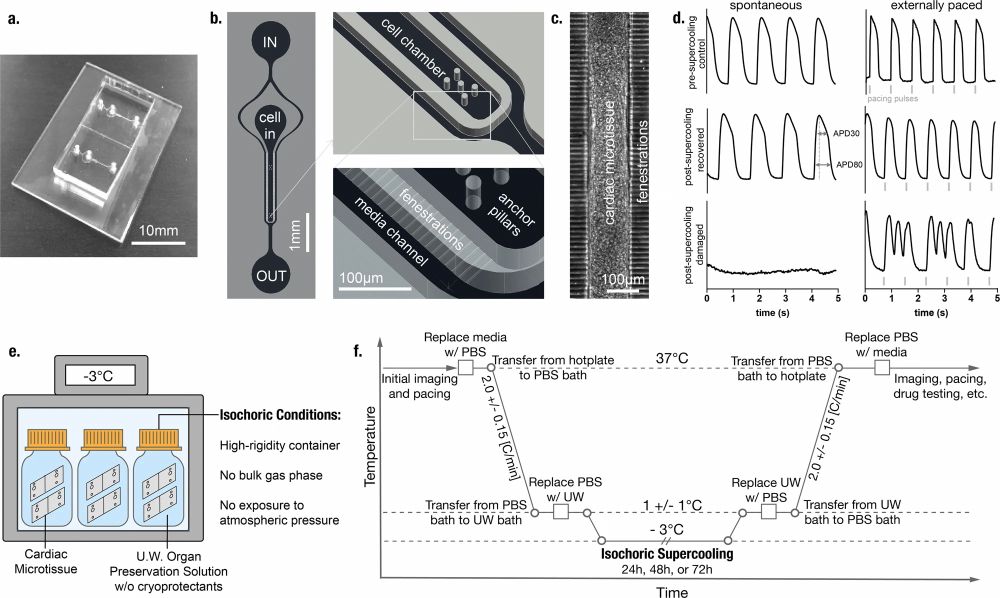
23 Sep Supercooled preservation and recovery of microfluidic human cardiac tissue cultures
“Low-temperature biopreservation and 3D tissue engineering present two different routes towards eventual on-demand access to transplantable biologics, but recent advances in both fields present critical new opportunities for crossover between them. With help of microfluidics, in this work, we demonstrate sub-zero centigrade preservation and revival of autonomously beating three-dimensional human induced pluripotent stem cell (hiPSC)-derived cardiac microtissues via isochoric supercooling, without the use of chemical cryoprotectants. We show that these tissues can cease autonomous beating during preservation and resume it after warming, that the supercooling process does not affect sarcomere structural integrity, and that the tissues maintain responsiveness to drug exposure following revival. Our work suggests both that functional three-dimensional (3D) engineered tissues may provide an excellent high-content, low-risk testbed to study complex tissue biopreservation in a genetically human context, and that isochoric supercooling may provide a robust method for preserving and reviving engineered tissues themselves.”

“a A glass-PDMS microfluidics device featuring two independent MPS. b Details of the microfluidic features including media inlet (IN) and outlet (OUT) as well as the cell loading port (cell in), cell chamber with anchor pillars, media channels, and connecting fenestration channels. c Cardiac microtissue after cellular self-assembly within the cell chamber. d Example fluorescence traces of a genetically encoded calcium channel reporter (GCaMP) showing spontaneous and externally triggered (1.25 Hz) beating activity before cryopreservation as well as disturbed and restored tissue function after cryopreservation. The width of the calcium transient at 30% and 80% peak amplitude was measured as a proxy for action potential duration (APD30 and APD80, respectively). e Isochoric supercooling enables the preservation of biological matter in a metastable ice-free condition at temperatures below the freezing point of water/physiological saline. Isochoric conditions are achieved by confining the preservation solution in a high-rigidity container totally absent of bulk gas phase and denying it access to the atmospheric pressure reservoir, which alters both equilibrium thermodynamics and ice nucleation kinetics of the system30,31. f Temperature–time schematic of the isochoric supercooling preservation protocol. ” Reproduced under Creative Commons Attribution 4.0 International License. from Powell-Palm, M.J., Charwat, V., Charrez, B. et al. Isochoric supercooled preservation and revival of human cardiac microtissues. Commun Biol 4, 1118 (2021)..
Figures and the abstract are reproduced from Powell-Palm, M.J., Charwat, V., Charrez, B. et al. Isochoric supercooled preservation and revival of human cardiac microtissues. Commun Biol 4,1118 (2021) under Creative Commons Attribution 4.0 International License
Read the original article: Isochoric supercooled preservation and revival of human cardiac microtissues


